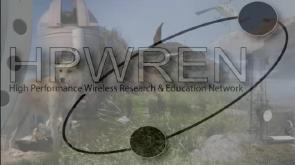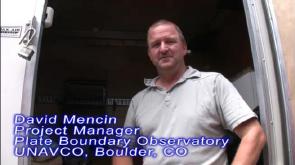
|
|
|
|
August 20, 2010
New earthquake sensor deployment by UC San Diego and UNAVCO near Anza, CA By Frank Vernon, Seismologist, Scripps Institution of Oceanography, UC San Diego This article includes a video about new earthquake sensor deployment on the San Jacinto fault near Anza, CA, which HPWREN will connect.
The following is the Project Summary from the NSF grant that supports the project: Summary The San Jacinto fault is one of the most active branches of the San Andreas system in southern CA, and it consists of multiple segments that exhibit considerably different properties and behaviors both at the surface and at depth. As such, it provides an excellent natural laboratory for studying the mechanics, architecture and evolutionary behavior of a young evolving plate boundary. The goal of this project is to provide improved quantitative understanding of brittle and aseismic deformation processes at a rapidly deforming plate boundary, by linking high-quality in-situ geological, geodetic and seismological data from the San Jacinto fault zone with theoretical analyses. We propose to conduct interdisciplinary observational studies of structural properties, earthquake source and geodetic deformation at various scales, as they relate to fault dynamics and the plate boundary tectonics in southern CA. Six distinct fault sections exist in the observation area with markedly different structural properties, slip-rates, earthquake behavior and locking depths. This diversity will enable us to perform comparative investigations of deformation processes and fault zone properties within a relatively small geographical area. Theoretical studies of dynamic ruptures and coupled evolution of earthquakes and fault structures will aid the interpretation of the observational results. The studies address several fundamental questions including: The project will phase in over five years, will leverage UNAVCO resources to be cost-effective, and will complement studies by other investigators focusing on the San Andreas and other major fault zones. Intellectual Merit and Broader impact: The study offers a fresh approach to plate-boundary deformation processes by focusing on the coupled evolution of earthquakes, faults and related deformation fields. The results will help resolve existing controversies and can have transformative impact on quantitative understanding of seismogenic processes and architecture of evolving continental plate-boundaries. The studies are expected to lead to new signals and new techniques in analyses of fault zone structures, fault zone geodesy, earthquake properties and earthquake geology. If we are successful, the results will help to considerably refine estimates of seismic shaking hazard in large urban areas near major continental faults. The research can also impact related studies on mechanics in the physics and engineering communities. The research will contribute to the education of numerous graduate and undergraduate students (with about 50% females), provide post-doctoral experience, and support the development of a young Assist. Prof. The research will provide valuable information to residents near the San Jacinto fault, and to building officials and emergency managers of the region. In partnership with the SCEC CEO program (USC Facilities), resources will be provided to the Riverside County Children's Museum "ShakeZone" exhibit (visited by over 20,000 students a year), and to the new Brown Center for Innovation which will have an even larger audience. The research activities will reach a broad audience through UCSD at the Preuss School (grades 6-12), the SIO Visualization Center, and SIO Birch Aquarium displays (UCSD Facilities). In coordination with SCEC CEO, teacher workshops are planned in years 4 and 5 as the scientific results become available. Technical workshops for engineers and building officials will be offered to foster implementation of research results, and media outreach activities will disseminate information broadly. Our multi-disciplinary approach on evolutionary plate-boundary processes should provide excellent material for the NSF E&O component. A well maintained set of web pages will evolve throughout this project and will be presented through USC, UCSD, SDSU, GT and SCEC. Part of the work will be done on the Ramona Indian reservation, which lies astride the San Jacinto fault near Anza; the tribal office is setting up an eco-tourism center on the reservation with an earthquake information center, and we will assist with that effort. |



